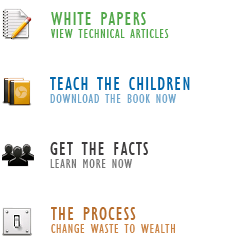 |
|||||||
 |
|||||||

How Waste is Changed into Wealth

Wastewater Treatment
The Sheaffer System incorporates a simple, open celled system that utilizes two universally abundant ingredients to reclaim wastewater, namely time and air. This is accomplished with just 3 pieces of equipment:
- macerator or grinder pump pulps the sewage prior to entry
- blower pump delivers compressed air into the system
- irrigation pump transfer the reclaimed water out of the system
By limiting the moving parts and designing them so that they only require basic human intervention, the reliability of the system exceeds that of any comparable conventional technology. By using interruptible power, a SMRRS can draw power on off-peak hours and help “even out” the load on the utility company’s power grid. This benefits both the power company and its customers, while taking advantage of discounts in off-peak electricity rates, thereby lowering operational costs.
Gravity and water density provide final forces needed to convey the sewage through the reclamation stages. Once reclaimed, the recycled water is free from the harmful organics, pharmaceuticals, and pathogens, and is available for municipal, commercial or, under certain conditions, even residential use. Data collected from over 25 years from monitoring facilities demonstrates that reclaimed water continues to meet the U.S. EPA maximum containment levels (MCLs) for drinking water, with essentially 0 fecal coliform and 0 E.coli. The reclaimed water still contains some levels of agriculturally beneficial nutrients; such as, nitrogen, phosphorus, and potassium.
Water Storage
The water is then conveyed to the storage reservoir where it is held during the non irrigation season. The water stabilizes to local climate conditions and until ready for use. The reservoir is designed or sized to insure adequate holding capacity when irrigation is not possible due to local weather conditions, crop management cycles, or other use requirements. An irrigation pump conveys the water via a sprinkler system to the required destination. Depending upon the desired quality standards a filtration system and/or disinfection process may be utilized prior to distribution from the storage reservoir.
Land Application
From the water storage reservoir, the reclaimed water and nutrients are pumped to nearby farms to irrigate the surrounding farmlands. This practice of irrigating farmland with reclaimed water increases the per hectare yield of cropland, while mitigating the affects of draught. Agricultural production costs are diminished, because the nutrients in the water lessen the need for petrochemical fertilizer. Air quality improves as stimulated plant growth pulls more carbon from the atmosphere. Reclaimed water also can be applied beneficially to recreational lands (golf courses, parks, athletic fields) natural areas, buffer lands and restored landscapes.
Harvest Options
Aside from the standard practice of harvesting a crop for sale in the marketplace, further linkages can be established by using the irrigation for ‘energy crops’ such as corn, sugar, and jatropha. Such crops can produce bio-fuels such as bio-diesel and ethanol. Corn production, for instance, would produce ethanol in an ethanol production facility. The production of ethanol, once blended with petroleum, will be sold as transportation fuel. Distilled brewers grain, a nutrient rich byproduct of the ethanol process, will be reused as a form of protein for animal’s rations. In addition to selling animals at market for human protein consumption, the animal’s manure can be processed into methane gas through use of an anaerobic energy harvester. The methane gas can then provide a power source for ethanol production, decreasing the facility’s reliance on outside electricity for its operation.
Nutrient and Carbon trading
The elimination of treated sewage discharge into local rivers and lakes, the reduction of petrochemical fertilizers and increased crop yield creates the opportunity for the community to sell carbon sequestration credits on the global carbon credit market. Once the reclaimed wastewater is linked to other agribusiness processes, carbon credits and other nutrient trading exchange opportunities would exist from the following practices:
- Carbon credits could be obtained from avoiding the use of natural gas in production of anhydrous ammonia (N) fertilizer by using the recycled nutrients.
- That same nitrogen in the form of recycled nutrients will increase the carbon sequestration of the soil.
- Changes in the operation of the sewage treatment plant can reduce electricity consumption.
- Modifications in the treatment processes can decrease the creation and leakage of methane to the atmosphere, which is used to generate power.
- The irrigation can be programmed to use off peak or interruptible electricity, which would otherwise be wasted to the atmosphere as heat.
- The production of phosphorus and potassium - typically created to fertilize and irrigate the acreage - will be replaced with recycled nutrients.
- Methane will be used to generate power at the confined animal feeding operation and will avoid direct methane discharges (burning emits CO2) and will eliminate the need to purchase fossil fuel based power.
- Mature woodlands that will be irrigated can sequester an additional 150 to 250 tons of carbon annually.
- Electricity used to pump groundwater to irrigate golf courses will no longer be needed.
Benefits
This integrated system also benefits the community through the creation of jobs which has a multiplying effect on the local economy by providing increased tax revenue and improving the residents’ standard of living. In summary the benefits of a wastewater reclamation and reuse facility linked to farmland, animal feeding operations and biomass production can yield the following benefits:
- Odor and pathogen reduction at municipal wastewater treatment facilities
- Carbon Credits
- Energy Savings
- Increased Crop Yield
- Job Creation
- Tax Revenue
- Commodity Creation
- Pollution mitigation and Eutrophication prevention
- Nitrogen and Phosphorus Fertilizer creation
- Flood defense
- Climate Change Mitigation
Learn more:
Get the facts about pollution
Review whitepapers on waste

